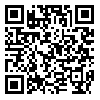Volume 22, Issue 1 (4-2023)
TB 2023, 22(1): 80-92 |
Back to browse issues page
Download citation:
BibTeX | RIS | EndNote | Medlars | ProCite | Reference Manager | RefWorks
Send citation to:



BibTeX | RIS | EndNote | Medlars | ProCite | Reference Manager | RefWorks
Send citation to:
Payahoo L, Amouei M, Shafaghi H, Bagherzade H, Askari S, Khajebishak Y. Assessment of the probiotic products usage barriers and the status of knowledge, attitude, practice in nurses and medical sciences students: A descriptive-analytical study. TB 2023; 22 (1) :80-92
URL: http://tbj.ssu.ac.ir/article-1-3456-en.html
URL: http://tbj.ssu.ac.ir/article-1-3456-en.html
Laleh Payahoo 

 , Mohammadjavad Amouei
, Mohammadjavad Amouei 

 , Haniye Shafaghi
, Haniye Shafaghi 
 , Hossein Bagherzade
, Hossein Bagherzade 
 , Shakibaa Askari
, Shakibaa Askari 
 , Yaser Khajebishak *
, Yaser Khajebishak * 




 , Mohammadjavad Amouei
, Mohammadjavad Amouei 

 , Haniye Shafaghi
, Haniye Shafaghi 
 , Hossein Bagherzade
, Hossein Bagherzade 
 , Shakibaa Askari
, Shakibaa Askari 
 , Yaser Khajebishak *
, Yaser Khajebishak * 


Department of Nutrition and Food Sciences, Maragheh University of Medical Sciences, Maragheh, Iran , khajebishaky@mail.com
Abstract: (1007 Views)
Introduction: Probiotics, as live microorganisms, exert beneficial effects on controlling diseases. Considering the lack of study in this field, the present study was conducted to assess the barriers of probiotic product's usage and the status of knowledge, attitude, and practice among nurses and medical sciences students in Maragheh city.
Methods: This descriptive-analytical study was carried out on 386 subjects (59 nurses and 327 students) of both genders at Maragheh University of Medical Sciences between 2020 and 2021. Convenience sampling was used on educational-therapeutic centers of Maragheh University of Medical Sciences. Data were collected by a questionnaire consisting of 35 questions, validity and reliability of which were previously evaluated. Independent sample t-test was used to compare the score of knowledge, attitude, performance and barriers, and Chi-square test was used to compare qualitative variables between the two groups of nurses and students.Values less than 0.05 was considered significant.
Results: Overall, 386 subjects (129 men and 257 women) completed the study. About 54% of participants did not have enough knowledge regarding probiotics. Regarding the barriers to consumption, nearly 57% stated that there was no comprehensive and sufficient information about probiotic products, and 46% of participants mentioned that access to probiotic products was poor. There was a significant difference (p<0.001) between the two groups in terms of being interested in learning more about probiotics, welcoming probiotic workshops, using live microbes in controlling diseases and in the family's shopping basket, the healthier status of probiotic foods compared with current supplements and the effect of probiotics on the outcome of the treatment protocol (p<0.001).
Conclusion: The involvement of media in raising awareness about the safety of probiotic products and general education in schools and the community through nurses and healthcare providers is recommended.
Methods: This descriptive-analytical study was carried out on 386 subjects (59 nurses and 327 students) of both genders at Maragheh University of Medical Sciences between 2020 and 2021. Convenience sampling was used on educational-therapeutic centers of Maragheh University of Medical Sciences. Data were collected by a questionnaire consisting of 35 questions, validity and reliability of which were previously evaluated. Independent sample t-test was used to compare the score of knowledge, attitude, performance and barriers, and Chi-square test was used to compare qualitative variables between the two groups of nurses and students.Values less than 0.05 was considered significant.
Results: Overall, 386 subjects (129 men and 257 women) completed the study. About 54% of participants did not have enough knowledge regarding probiotics. Regarding the barriers to consumption, nearly 57% stated that there was no comprehensive and sufficient information about probiotic products, and 46% of participants mentioned that access to probiotic products was poor. There was a significant difference (p<0.001) between the two groups in terms of being interested in learning more about probiotics, welcoming probiotic workshops, using live microbes in controlling diseases and in the family's shopping basket, the healthier status of probiotic foods compared with current supplements and the effect of probiotics on the outcome of the treatment protocol (p<0.001).
Conclusion: The involvement of media in raising awareness about the safety of probiotic products and general education in schools and the community through nurses and healthcare providers is recommended.
Type of Study: Research |
Subject:
Special
Received: 2022/12/10 | Accepted: 2023/03/5 | Published: 2023/04/30
Received: 2022/12/10 | Accepted: 2023/03/5 | Published: 2023/04/30
Send email to the article author
| Rights and permissions | |
 |
This work is licensed under a Creative Commons Attribution-NonCommercial 4.0 International License. |




